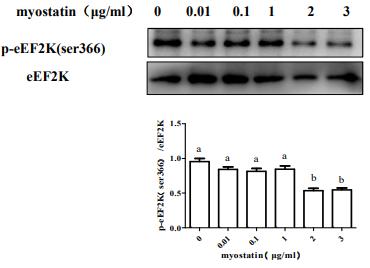eEF2K Antibody - #DF7323
製品説明
*The optimal dilutions should be determined by the end user. For optimal experimental results, antibody reuse is not recommended.
*Tips:
WB: For western blot detection of denatured protein samples. IHC: For immunohistochemical detection of paraffin sections (IHC-p) or frozen sections (IHC-f) of tissue samples. IF/ICC: For immunofluorescence detection of cell samples. ELISA(peptide): For ELISA detection of antigenic peptide.
引用形式: Affinity Biosciences Cat# DF7323, RRID:AB_2839261.
折りたたみ/展開
C86191; Calcium/calmodulin dependent eukaryotic elongation factor 2; Calcium/calmodulin dependent eukaryotic elongation factor 2 kinase; Calcium/calmodulin-dependent eukaryotic elongation factor 2 kinase; Calmodulin dependent protein kinase III; cb365; EC 2.7.11.20; eEF 2 kinase; eEF 2K; eEF-2 kinase; eEF-2K; Eef2k; EEF2K protein; EF2K_HUMAN; Elongation factor 2 kinase; Eukaryotic elongation factor 2 kinase; fa04b08; HSU93850; kinase eEF2K; MGC45041; SMEF2K; wu:fa04b08; zgc:100973;
免疫原
A synthesized peptide derived from human eEF2K, corresponding to a region within the internal amino acids.
- O00418 EF2K_HUMAN:
- Protein BLAST With
- NCBI/
- ExPASy/
- Uniprot
MADEDLIFRLEGVDGGQSPRAGHDGDSDGDSDDEEGYFICPITDDPSSNQNVNSKVNKYYSNLTKSERYSSSGSPANSFHFKEAWKHAIQKAKHMPDPWAEFHLEDIATERATRHRYNAVTGEWLDDEVLIKMASQPFGRGAMRECFRTKKLSNFLHAQQWKGASNYVAKRYIEPVDRDVYFEDVRLQMEAKLWGEEYNRHKPPKQVDIMQMCIIELKDRPGKPLFHLEHYIEGKYIKYNSNSGFVRDDNIRLTPQAFSHFTFERSGHQLIVVDIQGVGDLYTDPQIHTETGTDFGDGNLGVRGMALFFYSHACNRICESMGLAPFDLSPRERDAVNQNTKLLQSAKTILRGTEEKCGSPQVRTLSGSRPPLLRPLSENSGDENMSDVTFDSLPSSPSSATPHSQKLDHLHWPVFSDLDNMASRDHDHLDNHRESENSGDSGYPSEKRGELDDPEPREHGHSYSNRKYESDEDSLGSSGRVCVEKWNLLNSSRLHLPRASAVALEVQRLNALDLEKKIGKSILGKVHLAMVRYHEGGRFCEKGEEWDQESAVFHLEHAANLGELEAIVGLGLMYSQLPHHILADVSLKETEENKTKGFDYLLKAAEAGDRQSMILVARAFDSGQNLSPDRCQDWLEALHWYNTALEMTDCDEGGEYDGMQDEPRYMMLAREAEMLFTGGYGLEKDPQRSGDLYTQAAEAAMEAMKGRLANQYYQKAEEAWAQMEE
種類予測
Score>80(red) has high confidence and is suggested to be used for WB detection. *The prediction model is mainly based on the alignment of immunogen sequences, the results are for reference only, not as the basis of quality assurance.
High(score>80) Medium(80>score>50) Low(score<50) No confidence
研究背景
Threonine kinase that regulates protein synthesis by controlling the rate of peptide chain elongation. Upon activation by a variety of upstream kinases including AMPK or TRPM7, phosphorylates the elongation factor EEF2 at a single site, renders it unable to bind ribosomes and thus inactive. In turn, the rate of protein synthesis is reduced.
Autophosphorylated at multiple residues, Thr-348 being the major site. Phosphorylated by AMP-activated protein kinase AMPK at Ser-398 leading to EEF2K activation and protein synthesis inhibition. Phosphorylated by TRPM7 at Ser-78 resulting in improved protein stability, higher EE2F phosphorylated and subsequently reduced rate of protein synthesis. Phosphorylation by other kinases such as CDK1 and MAPK13 at Ser-359 or RPS6KA1 and RPS6KB1 at Ser-366 instead decrease EEF2K activity and promote protein synthesis.
Belongs to the protein kinase superfamily. Alpha-type protein kinase family.
研究領域
· Environmental Information Processing > Signal transduction > AMPK signaling pathway. (View pathway)
· Organismal Systems > Endocrine system > Oxytocin signaling pathway.
参考文献
Application: WB Species: mouse Sample:
Application: WB Species: mouse Sample: C2C12 myotubes
Restrictive clause
Affinity Biosciences tests all products strictly. Citations are provided as a resource for additional applications that have not been validated by Affinity Biosciences. Please choose the appropriate format for each application and consult Materials and Methods sections for additional details about the use of any product in these publications.
For Research Use Only.
Not for use in diagnostic or therapeutic procedures. Not for resale. Not for distribution without written consent. Affinity Biosciences will not be held responsible for patent infringement or other violations that may occur with the use of our products. Affinity Biosciences, Affinity Biosciences Logo and all other trademarks are the property of Affinity Biosciences LTD.

